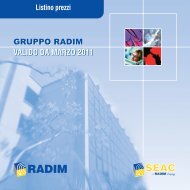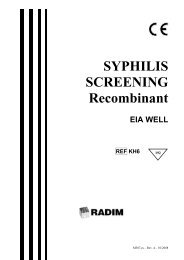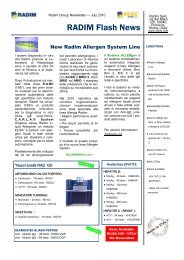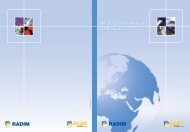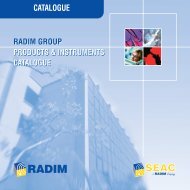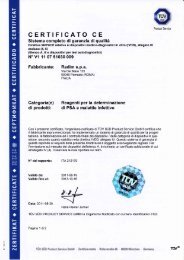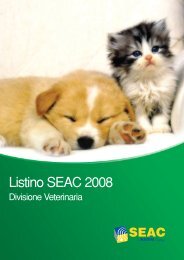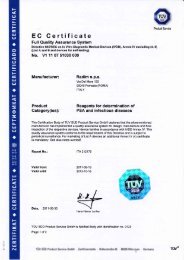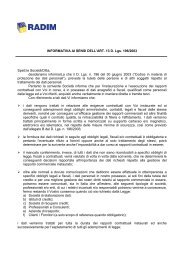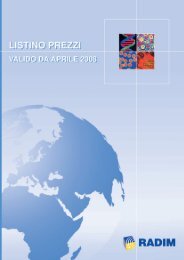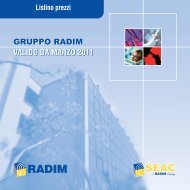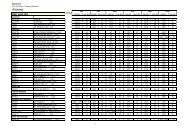CHLAMYDIA PNEUMONIAE IgA E.W. - Radim
CHLAMYDIA PNEUMONIAE IgA E.W. - Radim
CHLAMYDIA PNEUMONIAE IgA E.W. - Radim
Create successful ePaper yourself
Turn your PDF publications into a flip-book with our unique Google optimized e-Paper software.
0123<br />
<strong>CHLAMYDIA</strong><br />
<strong>PNEUMONIAE</strong> <strong>IgA</strong><br />
E.W.<br />
REF: K14CLA<br />
Italiano p. 3<br />
English p.12<br />
96<br />
M393 – Rev.0 – 07/2005
INDICE / INDEX<br />
1. INTRODUZIONE – INTRODUCTION<br />
2. USO PERVISTO – INTENDED USE<br />
3. PRINCIPIO DEL TEST – PRINCIPLE OF THE ASSAY<br />
4. MATERIALI – MATERIALS<br />
4.1 REAGENTI FORNITI – REAGENTS SUPPLIED<br />
4.2 ACCESSORI FORNITI – MATERIALS SUPPLIED<br />
4.3 MATERIALI ED ATTREZZATURE NECESSARI – MATERIALS AND EQUIPMENT NEEDED<br />
4.3.1 Dosaggio Manuale – Manual Test<br />
4.3.2 Dosaggio Automatico – Automatic Test<br />
5. MODALITA’ DI CONSERVAZIONE – STABILITY AND STORAGE<br />
6. PREPARAZIONE DEI REAGENTI – REAGENT PREPARATION<br />
6.1 MICROPIASTRA SENSIBILIZZATA – COATED MICROPLATE<br />
6.2 CONIUGATO <strong>CHLAMYDIA</strong> <strong>PNEUMONIAE</strong> ANTI-<strong>IgA</strong> – <strong>CHLAMYDIA</strong> <strong>PNEUMONIAE</strong> ANTI-<strong>IgA</strong><br />
CONJUGATE<br />
6.3 CONTROLLI – CONTROLS<br />
6.4 DILUENTE CAMPIONE <strong>IgA</strong> – <strong>IgA</strong> SAMPLE DILUENT<br />
6.5 TAMPONE DI LAVAGGIO (20X CONC.) – WASHING SOLUTION (20X CONC.)<br />
6.6 SOLUZIONE TMB SUBSTRATO – TMB SUBSTRATE SOLUTION<br />
6.7 SOLUZIONE STOP - STOP SOLUTION<br />
7. PRELIEVO E PREPARAZIONE DEI CAMPIONI – SPECIMEN COLLECTION AND PREPARATION<br />
7.1 DILUIZIONE DEI CAMPIONI – SAMPLE DILUTION<br />
8. PROCEDIMENTO – ASSAY PROCEDURE<br />
8.1 PREPARAZIONE DEL TEST – TEST PREPARATION<br />
8.2 MISURAZIONE – MEASUREMENT<br />
9. RISULTATI – RESULTS<br />
9.1 VALIDAZIONE DEL TEST – ASSAY VALIDATION CRITERIA<br />
9.2 CALCOLO DEI RISULTATI – CALCULATION OF RESULTS<br />
9.3 INTERPRETAZIONE DEI RISULTATI – INTERPRETATION OF RESULTS<br />
9.3.1 RISULTATI IN UNITA’ RADIM (UR) – RESULTS IN RADIM UNITS<br />
10. CARACTERISTICHE DEL TEST – SPECIFIC PERFORMANCE CHARACTERISTICS<br />
10.1 PRECISIONE - PRECISION<br />
10.2 SPECIFICITA’ DIAGNOSTICA – DIAGNOSTIC SPECIFICITY<br />
10.3 SENSIBILITA’ DIAGNOSTICA – DIAGNOSTIC SENSITIVITY<br />
10.4 POSSIBILI INTERFERENZE – POSSIBLE INTERFERENCES<br />
11. LIMITI DELLA PROCEDURA – LIMITATIONS OF THE PROCEDURE<br />
12. PRECAUZIONI ED AVVERTENZE – PRECAUTIONS AND WARNINGS<br />
12.1 SMALTIMENTO – DISPOSAL CONSIDERATIONS<br />
13. SCHEMA DEL DOSAGGIO – ASSAY SCHEME<br />
K14CLA – <strong>CHLAMYDIA</strong> <strong>PNEUMONIAE</strong> <strong>IgA</strong> E.W.<br />
M393 – Rev.0 – 07/2005 – Pag. 2/24
Test immunoenzimatico per la determinazione qualitativa degli<br />
anticorpi della classe <strong>IgA</strong> per Chlamydia Pneumoniae nel siero umano<br />
1. INTRODUZIONE<br />
Solo per uso diagnostico in vitro<br />
Le Clamidie sono batteri immobili Gram-negativi e parassiti intracellulari obbligati che formano<br />
caratteristiche inclusioni all’interno del citoplasma delle cellule infettate. Le Clamidie sono<br />
facilmente visibili al microscopio ottico. Si conoscono tre differenti specie di Clamidia patogene<br />
per l’uomo: Chlamydia trachomatis, Chlamydia pneumoniae e Chlamydia psittaci, ed una specie<br />
patogena solo per gli animali (C. pecorum). Chlamydia trachomatis rappresenta la principale<br />
causa delle malattie a trasmissione sessuale in tutto il mondo (400-500 milioni di casi) ed il<br />
numero di infezioni è in costante crescita. Le donne in gravidanza infettate da Chlamydia<br />
trachomatis possono trasmettere l’infezione al bambino durante il parto, provocando congiuntiviti<br />
o polmoniti neonatali. I casi di infezione da Clamidia non trattati possono degenerare, nelle<br />
donne, in salpingiti croniche, aumentando il rischio di gravidanze extrauterine o di sterilità. Negli<br />
uomini la Chlamydia trachomatis è il principale agente eziologico delle uretriti nongonococciche.<br />
Uno dei problemi più gravi ed insidiosi che caratterizzano le infezioni da Clamidia<br />
è il frequente decorso asintomatico della malattia, che può dare origine ad infezioni croniche. In<br />
molti casi l’infezione primaria non viene riconosciuta e vengono diagnosticate soltanto le sequele<br />
causate da infezioni ascendenti e persistenti.<br />
Specie<br />
C. trachomatis<br />
Modalità d’infezione Malattia Metodo diagnostico<br />
Trasmissione diretta o<br />
sessuale:<br />
il sito primario di infezione<br />
è generalmente la mucosa<br />
degli occhi ed il tratto<br />
urogenitale.<br />
C. pneumoniae Infiltrazione delle mucose<br />
del tratto respiratorio.<br />
C. psittaci Inalazione di feci<br />
provenienti da uccelli<br />
infetti;<br />
contatto con organi interni<br />
di uccelli infetti<br />
Linfogranuloma venereo (LGV)<br />
Tracoma<br />
Congiuntivite da corpi inclusi nei<br />
neonati e negli adulti.<br />
Cerviciti, salpingiti, uretriti,<br />
epididimiti, proctiti e polmoniti<br />
nei neonati.<br />
Malattie respiratorie, endocarditi,<br />
malattie coronariche<br />
Ornitosi (Psittacosi)<br />
Sierologia<br />
PCR<br />
Microscopia<br />
L’infezione può essere diagnosticata attraverso:<br />
• Microscopia: colorazione Giemsa<br />
• PCR<br />
• Sierologia: determinazione degli antigeni mediante ELISA<br />
determinazione degli anticorpi mediante immunofluorescenza, EIA, ELISA<br />
K14CLA – <strong>CHLAMYDIA</strong> <strong>PNEUMONIAE</strong> <strong>IgA</strong> E.W.<br />
M393 – Rev.0 – 07/2005 – Pag. 3/24
2. USO PREVISTO<br />
Il Chlamydia pneumoniae <strong>IgA</strong> E.W. è un kit per la determinazione qualitativa degli anticorpi<br />
specifici della classe <strong>IgA</strong> per Chlamydia pneumoniae nel siero umano.<br />
3. PRINCIPIO DEL TEST<br />
La determinazione qualitativa degli anticorpi <strong>IgA</strong> per Chlamydia pneumoniae si basa sul<br />
principio ELISA. I pozzetti delle micropiastre contengono una fase solida con antigeni specifici<br />
della Chlamydia pneumoniae. Anticorpi specifici nel campione si legano agli antigeni<br />
immobilizzati nei pozzetti. Gli anticorpi del coniugato (perossidasi di rafano-anticorpi anti-<strong>IgA</strong><br />
umani) si legano ai complessi antigene (fase solida)-anticorpo (paziente) nei campioni positivi.<br />
Questi complessi vengono evidenziati da una colorazione blu dopo l’incubazione con la<br />
soluzione TMB. L’intensità di questa colorazione è direttamente proporzionale alla quantità di<br />
anticorpi specifici per la Chlamydia pneumoniae di classe <strong>IgA</strong> presenti nel campione. Fermando<br />
la reazione enzimatica con acido solforico si causa un cambiamento di colore dal blu al giallo che<br />
può essere misurato facilmente con un fotometro per l’ELISA a 450 nm.<br />
4. MATERIALI<br />
4.1. Reagenti forniti<br />
MTP Micropiastra sensibilizzata con antigeni della Chlamydia pneumoniae<br />
(<strong>IgA</strong>): 12 strisce divisibili in 8 pozzetti, con adesi gli antigeni della<br />
Chlamydia pneumoniae; sigillate sotto vuoto, all’interno di una busta<br />
d’alluminio richiudibile.<br />
DIL Diluente campione <strong>IgA</strong>***: 1 flacone contenente 105 ml di tampone per<br />
diluire i campioni; pH 7.2 ± 0.2; color giallo; pronto all’uso.<br />
STOP Soluzione Stop: 1 flacone contenente 15 ml di acido solforico, 0.2 mol/l,<br />
pronto all’uso.<br />
WASH Tampone di Lavaggio (20x conc.)*: 1 flacone contenente 50 ml di un<br />
tampone concentrato 20 volte per il lavaggio dei pozzetti; pH 7.2 ± 0.2.<br />
CONJ Coniugato Chlamydia pneumoniae anti <strong>IgA</strong>**: 1 flacone contenente 20<br />
ml di anticorpi di coniglio anti-<strong>IgA</strong> umane, coniugati con perossidasi; color<br />
rosso; pronto all’uso.<br />
TMBDSUBS Soluzione TMB Substrato: 1 flacone contenente 15 ml di 3,3`,5,5`-<br />
Tetrametilbenzidina (TMB); pronto all’uso.<br />
POS Chlamydia pneumoniae <strong>IgA</strong> Controllo Positivo***: 1 flacone contenente<br />
2 ml di soluzione di controllo pronta all’uso; color giallo.<br />
C/O Chlamydia pneumoniae <strong>IgA</strong> Controllo Cut-off***: 1 flacone contenente<br />
2 ml di soluzione di controllo pronta all’uso; color giallo.<br />
NEG Chlamydia pneumoniae <strong>IgA</strong> Controllo Negativo***: 1 flacone<br />
contenente 2 ml di soluzione di controllo pronta all’uso;color giallo.<br />
* contiene: 0.2 % Kathon<br />
** contiene: 0.2 % Bronidox L<br />
*** contiene: 0.1 % Kathon e 0.095% Sodio Azide<br />
K14CLA – <strong>CHLAMYDIA</strong> <strong>PNEUMONIAE</strong> <strong>IgA</strong> E.W.<br />
M393 – Rev.0 – 07/2005 – Pag. 4/24
4.2. Accessori forniti<br />
1 supporto per micropiastre<br />
2 pellicole adesive<br />
1 istruzione per l’uso<br />
1 schema per la distribuzione ed identificazione di campioni e controlli<br />
4.3. Materiali e attrezzature necessari<br />
4.3.1 Dosaggio Manuale<br />
Fotometro per micropiastre con filtri da 450/620 nm<br />
Incubatore a 37°C<br />
Lavatore per micropiastre<br />
Micropipette con punte monouso (10, 100, 200, 1000 Ql)<br />
Vortex-Mixer<br />
Provette monouso<br />
Supporto per provette<br />
Acqua deionizzata o distillata<br />
Timer<br />
4.3.2 Dosaggio Automatico<br />
− Il dispositivo può essere utilizzato con strumentazione automatica di kit ELISA su<br />
micropiastra.<br />
− Si garantisce l'applicabilità su strumentazione RADIM e/o SEAC.<br />
− Qualora si utilizzi strumentazione automatica di altri fornitori è responsabilità<br />
dell'utilizzatore assicurarsi che il kit sia stato opportunamente validato.<br />
5. MODALITÀ DI CONSERVAZIONE<br />
I reagenti sono stabili fino alla data di scadenza indicata sull’etichetta se conservati a 2-8°C.<br />
6. PREPARAZIONE DEI REAGENTI<br />
Portare tutti i reagenti a temperatura ambiente (20-25°C) prima dell’uso!<br />
6.1. Micropiastra sensibilizzata<br />
I pozzetti con adesi gli antigeni inattivati della Chlamydia pneumoniae sono separabili e sigillati<br />
sotto vuoto. I pozzetti, pronti all’uso, devono essere conservati a 2-8°C. Riporre i pozzetti non<br />
utilizzati nel sacchetto con il gel essiccante di silice. Il prodotto è stabile fino alla data di<br />
scadenza indicata sull’etichetta se conservato a 2-8°C.<br />
6.2. Coniugato Chlamydia pneumoniae <strong>IgA</strong><br />
Il flacone contiene 20 ml di anticorpi anti-<strong>IgA</strong> umane coniugati con perossidasi di rafano,<br />
tampone, stabilizzanti, conservanti e un colorante inerte rosso. La soluzione è pronta per l’uso.<br />
Una volta aperto, il prodotto é stabile fino alla data di scadenza indicata sul flacone se<br />
conservato a 2-8°C.<br />
K14CLA – <strong>CHLAMYDIA</strong> <strong>PNEUMONIAE</strong> <strong>IgA</strong> E.W.<br />
M393 – Rev.0 – 07/2005 – Pag. 5/24
6.3. Controlli<br />
I flaconi del Controllo Positivo, Cut-off e Controllo Negativo contengono 2 ml di soluzione<br />
pronta all’uso. Una volta aperto, il prodotto é stabile fino alla data di scadenza indicata sul<br />
flacone se conservato a 2-8°C.<br />
6.4. Diluente campione <strong>IgA</strong><br />
Il flacone contiene 105 ml di tampone fosfato, stabilizzanti, conservanti e un colorante giallo<br />
inerte. La soluzione, pronta all’uso, viene usata per diluire i campioni. Una volta aperto, il<br />
prodotto é stabile fino alla data di scadenza indicata sul flacone se conservato a 2-8°C.<br />
6.5. Tampone di lavaggio (20x conc.)<br />
Il flacone contiene 50 ml di un tampone concentrato, detergenti e conservanti. Una volta aperto,<br />
il Tampone concentrato é stabile fino alla data di scadenza indicata sul flacone se conservato a<br />
2-8°C.<br />
Diluire il contenuto con acqua deionizzata o distillata (1 + 19), es.: 10 ml di Tampone di<br />
Lavaggio + 190 mL di acqua deionizzata o distillata. Una volta diluito, il tampone é stabile 5<br />
giorni se conservato a temperatura ambiente. Se sono presenti cristalli, scioglierli in bagnomaria<br />
a 37°C prima di diluire.<br />
Nota: Preparare solo il volume di tampone di lavaggio necessario per l’esecuzione del dosaggio.<br />
6.6. Soluzione TMB Substrato<br />
Il flacone contiene 15 ml di 3,3`,5,5`-Tetrametilbenzidina (TMB) e perossido di idrogeno pronto<br />
all’uso. Conservare al buio. La soluzione é incolore o celeste chiaro. Nel caso in cui diventasse<br />
blu significa che é contaminata e non puó essere piú usata. Una volta aperto, il prodotto é stabile<br />
fino alla data di scadenza indicata sul flacone se conservato a 2-8°C.<br />
6.7. Soluzione Stop<br />
Il flacone contiene 15 ml di acido solforico, 0.2 mol/l, pronto all’uso. Una volta aperto, il<br />
prodotto é stabile fino alla data di scadenza indicata sul flacone se conservato a 2-8°C.<br />
7. PRELIEVO E PREPARAZIONE DEI CAMPIONI<br />
Usare campioni di siero umano. Se il test viene fatto entro 24 ore dal prelievo i campioni possono<br />
essere conservati a 2-8°C; altrimenti devono essere aliquotati e congelati tra -70…-20°C. Agitare<br />
bene i campioni scongelati prima di diluirli.<br />
Evitare cicli ripetuti di congelamento/scongelamento.<br />
7.1. Diluizione dei campioni<br />
Prima del test, diluire i campioni 1 + 100 con il diluente campione <strong>IgA</strong>. Per esempio, pipettare<br />
nelle provette 10 Ql di campione + 1 ml di diluente e mescolare bene (Vortex). I controlli sono<br />
pronti all’uso e non necessitano di diluizione.<br />
K14CLA – <strong>CHLAMYDIA</strong> <strong>PNEUMONIAE</strong> <strong>IgA</strong> E.W.<br />
M393 – Rev.0 – 07/2005 – Pag. 6/24
8. PROCEDIMENTO<br />
8.1. Preparazione del test<br />
Leggere bene le istruzioni prima di iniziare il dosaggio. Per ottenere risultati validi é<br />
indispensabile seguire esattamente le istruzioni. La seguente procedura è stata validata per<br />
l’esecuzione manuale. Per una esecuzione su strumentazione automatica si consiglia di<br />
incrementare il numero di lavaggi da 3 (tre) a 5 (cinque), ed il volume della soluzione di lavaggio<br />
da 300Ql a 350Ql. Stabilire innanzitutto lo schema di distribuzione ed identificazione di<br />
campioni e controlli sul foglio di lavoro fornito con il kit. Inserire i pozzetti necessari nel<br />
supporto micropiastre.<br />
Utilizzare almeno:<br />
1 pozzetto (es. A1) per il bianco (blank)<br />
1 pozzetto (es. B1) per il controllo negativo<br />
2 pozzetti (es. C1+D1) per il controllo Cut-off<br />
1 pozzetto (es. E1) per il controllo positivo.<br />
È consigliato effettuare il dosaggio in duplicato.<br />
Eseguire il test nell’ordine stabilito dalle istruzioni, senza pause.<br />
Utilizzare puntali nuovi e puliti per ogni campione e controllo.<br />
Regolare l’incubatore a 37° ± 1°C<br />
1. Pipettare 100 Ql di ogni controllo e dei campioni diluiti nei relativi pozzetti. Usare il<br />
pozzetto A1 per il Bianco.<br />
2. Coprire i pozzetti con la pellicola adesiva.<br />
3. Incubare 1 ora ± 5 min a 37° ± 1°C.<br />
4. Al termine dell’incubazione, togliere la pellicola ed aspirare il liquido dai pozzetti.<br />
Successivamente lavare i pozzetti tre volte con 300 Ql di tampone di lavaggio. Evitare<br />
che la soluzione trabocchi dai pozzetti. L’intervallo tra il lavaggio e l’aspirazione deve<br />
essere almeno di 5 sec. Dopo il lavaggio picchiettare delicatamente i pozzetti con<br />
l’apertura verso il basso su una carta assorbente per togliere completamente il liquido.<br />
Attenzione: Il lavaggio é una fase critica. Un lavaggio non accurato determina una<br />
cattiva precisione del test ed un innalzamento falsato delle densità ottiche.<br />
5. Pipettare 100Ql di Coniugato Chlamydia pneumoniae anti-<strong>IgA</strong> in tutti i pozzetti,<br />
escludendo quello con il Bianco (Blank). Coprire i pozzetti con la pellicola adesiva.<br />
6. Incubare 30 min a temperatura ambiente (20°...25°C). Non esporre a fonti di luce<br />
diretta.<br />
7. Ripetere il lavaggio come indicato al punto 4.<br />
8. Pipettare 100Ql di Soluzione TMB-substrato in tutti i pozzetti.<br />
9. Incubare precisamente per 15 min a temperatura ambiente (20°...25°C) al buio.<br />
10. Pipettare 100Ql di Soluzione Stop in tutti i pozzetti, nello stesso ordine della soluzione<br />
TMB. Durante l’incubazione il colore cambia dal blu al giallo.<br />
K14CLA – <strong>CHLAMYDIA</strong> <strong>PNEUMONIAE</strong> <strong>IgA</strong> E.W.<br />
M393 – Rev.0 – 07/2005 – Pag. 7/24
Attenzione: Campioni con un risultato altamente positivo possono causare precipitati<br />
scuri del cromogeno! Questi precipitati influenzano la lettura della densità<br />
ottica. È consigliato diluire i campioni con soluzione fisiologica NaCl,<br />
esempio 1+1. Poi diluire normalmente 1 + 100 con tampone diluente <strong>IgA</strong>. Il<br />
risultato in UR viene moltiplicato per due.<br />
11. Misurare l’assorbanza di tutti i pozzetti a 450/620 nm entro 30 min dall’aggiunta della<br />
Soluzione Stop.<br />
Qualora si utilizzasse nel procedimento operativo uno strumento automatico per<br />
micropiastre RADIM/SEAC, far riferimento al relativo manuale”.<br />
8.2. Misurazione<br />
Regolare il fotometro per le micropiastre (ELISA-Reader) a zero usando il Bianco (Blank) in<br />
A1. Se, per motivi tecnici, non é possibile regolare il fotometro sottrarre l’assorbanza del Bianco<br />
da tutti i valori delle altre assorbanze in modo da ottenere risultati attendibili.<br />
Misurare l’assorbanza di tutti i pozzetti a 450 nm e inserire tutti i valori ottenuti nel foglio di<br />
lavoro.<br />
É raccomandato fare una misurazione delle densità ottiche a doppia lunghezza d’onda<br />
utilizzando i 620 nm come lunghezza di riferimento.<br />
Laddove applicabile calcolare la media dei valori delle assorbanze di tutti i duplicati.<br />
9. RISULTATI<br />
9.1. Validazione del test<br />
Il test é valido se risponde ai seguenti criteri:<br />
Bianco in A1: Valore di assorbanza inferiore a 0.100<br />
Controllo negativo in B1: Valore di assorbanza inferiore a 0.200<br />
Controllo Cut-off in C1 e D1: Valore di assorbanza tra 0.250 e 0.900<br />
Controllo positivo in E1: Valore di assorbanza più alto o uguale al<br />
valore del Cut-Off<br />
9.2. Calcolo dei risultati<br />
Il Cut-Off e’ la media dei valori di assorbanza dei controlli Cut-off.<br />
Esempio: Valore di assorbanza del controllo Cut-off 0.44 + valore di assorbanza del<br />
controllo Cut-off 0.42 = 0.86/2= 0.43<br />
Cut-Off = 0.43<br />
9.3. Interpretazione dei risultati *<br />
X I campioni con valore di assorbanza superiore al Cut-off + 10% sono da considerare Positivi.<br />
X I campioni con valore di assorbanza compreso nel range del Cut-off ± 10% non sono<br />
identificabili come positivi o negativi e quindi il risultato viene considerato Dubbio.<br />
In questo caso é raccomandato di ripetere il test dopo 2 o 4 settimane con un campione fresco.<br />
Se il risultato é ancora incerto il campione viene considerato Negativo.<br />
X I campioni con valore di assorbanza inferiore al Cut-off -10% sono da considerare Negativi.<br />
K14CLA – <strong>CHLAMYDIA</strong> <strong>PNEUMONIAE</strong> <strong>IgA</strong> E.W.<br />
M393 – Rev.0 – 07/2005 – Pag. 8/24
* Nel caso si utilizzi uno strumento automatico per micropiastra RADIM e/o SEAC, la<br />
lettura spettrofotometrica è eseguita automaticamente a 3 lunghezze d’onda: 450, 405, 620<br />
nm, permettendo l’ampliamento del range di lettura.<br />
9.3.1. Risultati in Unità RADIM [UR]<br />
Assorbanza media del campione x 10 = [Unità RADIM = UR]<br />
Cut-Off<br />
Esempio: 1.204 x 10<br />
0.43<br />
= 28 UR (Unità RADIM)<br />
Cut-Off : 10 UR<br />
Dubbio: 9-11 UR<br />
Negativo: 11 UR<br />
10. CARATTERISTICHE DEL TEST<br />
10.1. Precisione<br />
Riproducibilità:<br />
Interdosaggio n Media (UR) CV (%)<br />
Siero pos. 12 22.2 9.7<br />
Siero pos. 12 16.3 14.0<br />
Ripetibilità:<br />
Intradosaggio n Media (OD) CV (%)<br />
Siero pos. 20 1.20 4.9<br />
Siero pos. 24 0.84 8.3<br />
10.2. Specificità diagnostica<br />
La specificità diagnostica é la probabilità del test di fornire un risultato negativo in assenza di<br />
anticorpi specifici. La specificità diagnostica é > 95%.<br />
10.3. Sensibilità diagnostica<br />
La sensibilità diagnostica é la probabilità del test di fornire un risultato positivo in presenza di<br />
anticorpi specifici. La sensibilità diagnostica é pari a 88.9%.<br />
10.4. Possibili interferenze<br />
Campioni emolitici, lipemici ed itterici contenenti fino a 10 mg/mL di emoglobina, 5 mg/mL di<br />
trigliceridi e 0,2 mg/mL di bilirubina non hanno presentato fenomeni di interferenza nel presente<br />
test.<br />
K14CLA – <strong>CHLAMYDIA</strong> <strong>PNEUMONIAE</strong> <strong>IgA</strong> E.W.<br />
M393 – Rev.0 – 07/2005 – Pag. 9/24
11. LIMITI DELLA PROCEDURA<br />
Una contaminazione batterica o ripetuti cicli di congelamento-scongelamento possono alterare i<br />
valori delle assorbanze. La diagnosi di una malattia infettiva non deve essere fatta soltanto sulla<br />
base della risultanza di un unico test. Una diagnosi precisa deve prendere in considerazione anche<br />
l’anamnesi, i sintomi del paziente e i dati derivanti dalle analisi sierologiche. I risultati sierologici<br />
provenienti da pazienti immunosoppressi e dai neonati hanno un valore limitato.<br />
L’antigene di Chlamydia pneumoniae che è adeso sulle micropiastre è costituito da corpi<br />
elementari. In caso di sieri contenenti anticorpi nei confronti di LPS e MOMP non può essere<br />
esclusa una contaminazione crociata con Chlamydia trachomatis.<br />
12. PRECAUZIONI E AVVERTENZE<br />
In ottemperanza alla direttiva Europea 98/79/EC l’uso dei dispositivi medico-diagnostici in<br />
vitro è inteso da parte del fabbricante ad assicurare la congruenza, le prestazioni e la<br />
sicurezza del prodotto. Di conseguenza la procedura analitica, le informazioni, le precauzioni<br />
e le avvertenze contenute nelle istruzioni per l’uso devono essere seguite scrupolosamente.<br />
L’uso dei kit con analizzatori e attrezzature similari deve essere previamente convalidato.<br />
Qualunque cambiamento nel progetto, nella composizione o struttura e nella procedura<br />
analitica, così come qualunque uso dei kit in associazione ad altri prodotti non approvati dal<br />
fabbricante non è autorizzato; l’utilizzatore stesso è responsabile di questi eventuali<br />
cambiamenti. Il fabbricante non è responsabile di falsi risultati e incidenti che possano essere<br />
causati da queste ragioni. Il fabbricante non è responsabile di qualunque risultato ottenuto<br />
attraverso l’esame visivo dei campioni dei pazienti.<br />
Solo per uso diagnostico in-vitro.<br />
Tutti i componenti di origine umana impiegati nella produzione dei reagenti contenuti nel kit<br />
sono stati trovati non reattivi ad Anti-HIV-Ab, Anti-HCV-Ab e HBsAg. Nonostante ciò tutti<br />
i materiali devono comunque essere considerati potenzialmente contagiosi e infettivi.<br />
La sodio azide, contenuta come conservante in alcuni reagenti, può reagire con il piombo ed<br />
il rame delle tubature formando azidi di metallo altamente esplosive. Per evitare la<br />
formazione e l'accumulo di tali composti far scorrere abbondante acqua sui reagenti<br />
eliminati.<br />
Non scambiare reagenti e micropiastre di lotti diversi.<br />
Non utilizzare reagenti di altri fabbricanti insieme ai reagenti di questo kit.<br />
Non usare i reagenti dopo la data di scadenza indicata sull’etichetta.<br />
Utilizzare soltanto attrezzatura (puntali, dispensatori) e materiale di laboratorio puliti.<br />
Non scambiare i tappi dei flaconi in modo da evitare contaminazioni crociate.<br />
Richiudere bene i flaconi immediatamente dopo l’uso per evitare fenomeni di evaporazione e<br />
contaminazione microbica dei reagenti.<br />
Una volta aperti e dopo relativo stoccaggio verificare i reagenti, prima dell’uso, al fine di<br />
escludere una loro eventuale contaminazione microbica.<br />
Per evitare contaminazioni crociate e risultati erroneamente alti pipettare campioni e reagenti<br />
con molta precisione sul fondo dei pozzetti, evitando la formazione di schizzi.<br />
K14CLA – <strong>CHLAMYDIA</strong> <strong>PNEUMONIAE</strong> <strong>IgA</strong> E.W.<br />
M393 – Rev.0 – 07/2005 – Pag. 10/24
ATTENZIONE: Bronidox L, nella concentrazione usata, non presenta quasi alcun rischio di<br />
tossicità sulla pelle e sulle mucose.<br />
ATTENZIONE: L’acido solforico irrita occhi e pelle! In caso di contatto sciacquare<br />
immediatamente con abbondante acqua e contattare un medico. Mantenere<br />
fuori dalla portata dei bambini.<br />
12.1. Smaltimento<br />
In genere tutte le sostanze chimiche vengono considerate rifiuti tossici. Lo smaltimento di questo<br />
tipo di materiale viene regolato da leggi nazionali e regolamenti regionali. Per ulteriori<br />
informazioni contattare le autorità locali o le società autorizzate allo smaltimento dei rifiuti.<br />
13. SCHEMA DEL DOSAGGIO<br />
Chlamydia pneumoniae <strong>IgA</strong> E.W.<br />
Preparazione<br />
Preparare campioni, controlli e reagenti come indicato.<br />
Stabilire lo schema di distribuzione ed identificazione di campioni e controlli sull’apposito foglio<br />
fornito nel kit.<br />
Inserire la quantità di pozzetti necessari nel supporto per micropiastre.<br />
Procedimento<br />
Bianco (A1) NEG POS C/O<br />
Campione<br />
(diluito 1+100)<br />
NEG - 100Ql - - -<br />
POS - - 100Ql - -<br />
C/O - - - 100Ql -<br />
Campione<br />
(diluito 1+100)<br />
- - - - 100Ql<br />
Coprire la micropiastra con la pellicola<br />
Incubare per 1 ora ± 5 min a 37°C ± 1°C<br />
Lavare 3 x con 300Ql di tampone di lavaggio<br />
CONJ - 100Ql 100Ql 100Ql 100Ql<br />
Coprire la micropiastra con la pellicola<br />
Incubare per 30 min a temperatura ambiente<br />
Lavare 3 x con 300Ql di tampone di lavaggio<br />
TMBDSUBS 100Ql 100Ql 100Ql 100Ql 100Ql<br />
Incubare per 15 min a temperatura ambiente al buio<br />
STOP 100Ql 100Ql 100Ql 100Ql 100Ql<br />
Misurazione fotometrica a 450 nm (lunghezza d’onda di riferimento: 620 nm)<br />
K14CLA – <strong>CHLAMYDIA</strong> <strong>PNEUMONIAE</strong> <strong>IgA</strong> E.W.<br />
M393 – Rev.0 – 07/2005 – Pag. 11/24
Enzyme immunoassay for the qualitative determination of <strong>IgA</strong>-class<br />
antibodies against Chlamydia Pneumoniae in human serum<br />
1. INTRODUCTION<br />
Only for in-vitro diagnostic use<br />
Chlamydiae are no mobile, Gram negative and obligatory intracellular growing bacteria which<br />
form characteristic inclusions within the cytoplasm of parasitized cells. They are easily visible in<br />
the light microscope. Three different Chlamydia species pathogenic for humans are known:<br />
Chlamydia trachomatis, Chlamydia pneumoniae and Chlamydia psittaci, and one species only<br />
pathogenic for animals (C. pecorum). Chlamydia trachomatis is the most prevalent agent of<br />
sexually transmitted diseases worldwide (400-500 million cases) and the number of infections is<br />
constantly growing. Pregnant women infected with C. trachomatis may transmit these bacteria<br />
during childbirth, causing conjunctivitis or pneumonia in newborns. Untreated cases of<br />
chlamydial infection can lead to chronic salpingitis, possibly resulting in ectopic pregnancy or<br />
infertility. In males, C. trachomatis is a major cause of non-gonococcal urethritis. A severe<br />
problem in Chlamydia infections is the frequent asymptomatic insidious course which may result<br />
in the initiation of chronic diseases. In many instances primary infections are not recognized and<br />
only the sequelae caused by ascended, persisting agents are diagnosed.<br />
Species Mechanism of infection Disease Diagnostics<br />
C. trachomatis Direct or sexual<br />
Lymphogranuloma venereum<br />
transmission:<br />
(LGV)<br />
The primary site of Trachoma<br />
infection usually is the Inclusion conjunctivitis of Serology<br />
mucous membrane of the neonates and adults; Cervicitis,<br />
eye or the urogenital tract salpingitis, urethritis,<br />
epididymitis, proctitis and<br />
PCR<br />
pneumonia of newborns Microscopy<br />
C. pneumoniae Infiltration of the mucous Respiratory diseases<br />
membrane of the<br />
discussed: endocarditis,<br />
respiratory tract<br />
coronary<br />
heart diseases<br />
C. psittaci Inhalation of feces from<br />
infected birds;<br />
contact with infected avian<br />
viscera<br />
Ornithosis (Psittacosis)<br />
Infection may be identified by<br />
Microscopy: Giemsa stain<br />
PCR<br />
Serology: Detection of antigens by ELISA<br />
Detection of antibodies by IF, EIA, ELISA<br />
K14CLA – <strong>CHLAMYDIA</strong> <strong>PNEUMONIAE</strong> <strong>IgA</strong> E.W.<br />
M393 – Rev.0 – 07/2005 – Pag. 12/24
2. INTENDED USE<br />
The Chlamydia pneumoniae <strong>IgA</strong> E.W. is intended for the qualitative determination of <strong>IgA</strong> class<br />
antibodies against Chlamydia pneumoniae in human serum.<br />
3. PRINCIPLE OF THE ASSAY<br />
The qualitative immunoenzymatic determination of <strong>IgA</strong>-class antibodies against Chlamydia<br />
pneumoniae is based on the ELISA (Enzyme-linked Immunosorbent Assay) technique.<br />
Microtiter strip wells are precoated with Chlamydia pneumoniae antigens to bind corresponding<br />
antibodies of the specimen. After washing the wells to remove all unbound sample material<br />
horseradish peroxidase (HRP) labelled anti-human <strong>IgA</strong> conjugate is added. This conjugate binds<br />
to the captured Chlamydia pneumoniae-specific antibodies. The immune complex formed by the<br />
bound conjugate is visualized by adding Tetramethylbenzidine (TMB) substrate which gives a<br />
blue reaction product. The intensity of this product is proportional to the amount of Chlamydia<br />
pneumoniae-specific <strong>IgA</strong> antibodies in the specimen. Sulphuric acid is added to stop the reaction.<br />
This produces a yellow endpoint colour. Absorbance at 450 nm is read using an ELISA<br />
microwell plate reader.<br />
4. MATERIALS<br />
4.1. Reagents supplied<br />
MTP Chlamydia pneumoniae Coated Microplate (<strong>IgA</strong>): 12 breakapart 8well<br />
snap-off strips coated with Chlamydia pneumoniae antigen; vacuum<br />
sealed, in resealable aluminium foil.<br />
DIL <strong>IgA</strong> Sample Diluent ***: 1 bottle containing 105 ml of ready to use<br />
buffer for sample dilution; pH 7.2 ± 0.2; coloured yellow.<br />
STOP Stop Solution: 1 bottle containing 15 ml of sulphuric acid, 0.2 mol/l;<br />
ready to use.<br />
WASH Washing Solution (20x conc.)*: 1 bottle containing 50 ml of a 20-fold<br />
concentrated buffer (pH 7.2 ± 0.2) for washing the wells.<br />
CONJ Chlamydia pneumoniae anti-<strong>IgA</strong> Conjugate**: 1 bottle containing 20<br />
ml of rabbit antibody anti-human <strong>IgA</strong> labelled with peroxidase; coloured<br />
red, ready to use.<br />
TMBDSUSB TMB Substrate Solution: 1 bottle containing 15 ml of 3,3',5,5'tetramethylbenzidine<br />
(TMB); ready to use.<br />
POS Chlamydia pneumoniae <strong>IgA</strong> Positive Control***: 1 bottle containing 2<br />
ml of a ready to use control solution; coloured yellow.<br />
C/O Chlamydia pneumoniae <strong>IgA</strong> Cut-off Control***: 1 bottle containing 2<br />
ml of a ready to use control solution; coloured yellow.<br />
NEG Chlamydia pneumoniae <strong>IgA</strong> NegativeControl***: 1 bottle containing<br />
2 ml of a ready to use control solution; coloured yellow.<br />
* contains: 0.2 % Kathon<br />
** contains: 0.2 % Bronidox L<br />
*** contains: 0.1 % Kathon and 0.095% Sodium Azide<br />
K14CLA – <strong>CHLAMYDIA</strong> <strong>PNEUMONIAE</strong> <strong>IgA</strong> E.W.<br />
M393 – Rev.0 – 07/2005 – Pag. 13/24
4.2. Materials supplied<br />
1 Strip holder<br />
2 Cover foils<br />
1 Instruction for use<br />
1 Distribution and identification plan for samples and controls<br />
4.3. Materials and Equipment needed<br />
4.3.1 Manual Test<br />
ELISA microwell plate reader, equipped for the measurement of absorbance at 450/620nm<br />
Incubator 37°C<br />
Manual or automatic equipment for rinsing wells<br />
Micropipettes and disposable plastic tips (10, 100, 200, 1000 Ql)<br />
Vortex tube mixer<br />
Disposable tubes<br />
Pipe stand<br />
Deionised or (freshly) distilled water<br />
Timer<br />
4.3.2 AutomaticTest<br />
− This test can be used with automatic instrument for ELISA kits on microplate.<br />
− We guarantee its applications on RADIM and/or SEAC automatic instruments.<br />
− While using a non RADIM or SEAC automatic instrument for microplate, it is under end<br />
user responsibility, to make sure that it was appropriately tested for ELISA kits.<br />
5. STABILITY AND STORAGE<br />
The reagents are stable up to the expiry date stated on the label when stored at 2...8 °C.<br />
6. REAGENT PREPARATION<br />
It is very important to bring all the reagents to room temperature (20…25°C) before starting the<br />
test run!<br />
6.1. Coated Microplate<br />
The ready to use breakapart snap-off strips are coated with Chlamydia pneumoniae antigen. Store<br />
at 2...8°C. The strips are vacuum sealed. Immediately after removal of strips, the remaining strips<br />
should be resealed in the aluminium foil along with the desiccant supplied. Once opened are<br />
stable until expiry date indicated on the label, if stored at 2…8°C.<br />
6.2. Chlamydia pneumoniae anti-<strong>IgA</strong> Conjugate<br />
The bottle contains 20 ml of a solution with anti-human-<strong>IgA</strong> labelled with horseradish<br />
peroxidase, buffer, stabilizers, preservatives and an inert red dye. The solution is ready to use.<br />
Store at 2...8°C. Once opened, it is stable until the expiry date indicated on the vial’s label, if<br />
stored at 2…8°C.<br />
K14CLA – <strong>CHLAMYDIA</strong> <strong>PNEUMONIAE</strong> <strong>IgA</strong> E.W.<br />
M393 – Rev.0 – 07/2005 – Pag. 14/24
6.3. Controls<br />
Positive Control, Cut-off and Negative Control contain 2 ml of a solution ready to use. Store at<br />
2...8°C. Once opened, controls are stable until the expiry date indicated on the vial’s label if<br />
stored at 2…8°C.<br />
6.4. <strong>IgA</strong> Sample Diluent<br />
The bottle contains 105 ml of phosphate buffer, stabilizers, preservatives and an inert yellow dye.<br />
It is used for the dilution of the patient specimen. This ready to use solution has to be stored at<br />
2...8°C. Once opened, it is stable until the expiry date indicated on the vial’s label, if stored at<br />
2…8°C.<br />
6.5. Washing Solution (20X conc.)<br />
The bottle contains 50 ml of a concentrated buffer, detergents and preservatives. Once opened the<br />
concentrate Washing Solution is stable until the expiry date indicated on the vial’s label if stored<br />
at 2…8°C.<br />
Dilute washing solution with deionized or distilled water 1+19 (e.g. 10 ml of washing solution +<br />
190 ml of deionized or distilled water). Once diluted, buffer will keep for 5 days if stored at room<br />
temperature. Crystals in the solution disappear by warming up to 37 °C in a water bath.<br />
Note: Prepare only the volume of washing solution necessary for the assay’s carrying out.<br />
6.6. TMB Substrate Solution<br />
The bottle contains 15 ml of a tetramethylbenzidine/hydrogen peroxide system. The reagent is<br />
ready to use and has to be stored at 2...8°C, away from the light. The solution should be<br />
colourless or could have a slight blue tinge. If the substrate turns into blue, it may have become<br />
contaminated and should be discharged. Once opened it is stable until the expiry date indicated<br />
on the vial’s label if stored at 2…8°C.<br />
6.7. Stop Solution<br />
The bottle contains 15 ml of 0.2 M sulphuric acid solution. This ready to use solution has to be<br />
stored at 2...8°C.<br />
Once opened, it is stable until the expiry date indicated on the vial’s label if stored at 2...8°C.<br />
7. SPECIMEN COLLECTION AND PREPARATION<br />
Human serum may be used. If the assay is performed within 24 hours after sample collection, the<br />
specimen should be kept at 2...8°C; otherwise they should be aliquoted and stored deep-frozen (-<br />
70…-20°C). If samples are stored frozen, mix thawed samples well before testing.<br />
Avoid repeated freezing and thawing.<br />
7.1. Sample Dilution<br />
Before assaying, all samples should be diluted 1+100 with <strong>IgA</strong> Sample Diluent. Dispense 10Ql of<br />
sample and 1mL of <strong>IgA</strong> Sample Diluent into tubes to obtain a 1+100 dilution and thoroughly mix<br />
with a Vortex. Controls are ready to use and must not be diluted.<br />
K14CLA – <strong>CHLAMYDIA</strong> <strong>PNEUMONIAE</strong> <strong>IgA</strong> E.W.<br />
M393 – Rev.0 – 07/2005 – Pag. 15/24
8. ASSAY PROCEDURE<br />
8.1. Test Preparation<br />
Please read the test protocol carefully before performing the assay. Result reliability depends on<br />
strict adherence to the test protocol as described. The following test procedure is only validated<br />
for manual procedure. If performing the test on ELISA automatic systems we recommend to<br />
increase the washing steps from three to five and the volume of washing solution from 300Ql to<br />
350Ql to avoid washing effects. Prior to commencing the assay, the distribution and identification<br />
plan for all specimens and controls should be carefully established on the result sheet supplied in<br />
the kit. Select the required number of microtiter strips or wells and insert them into the holder.<br />
Please allocate at least:<br />
1 well (e.g. A1) for the blank,<br />
1 well (e.g. B1) for the negative control,<br />
2 wells (e.g. C1+D1) for the cut-off control and<br />
1 well (e.g. E1) for the positive control.<br />
It is recommended to perform the assay in duplicate.<br />
Perform all assay steps in the order given and without any appreciable delays between the steps.<br />
A clean, disposable tip should be used for dispensing each control and sample.<br />
Adjust the incubator to 37° ± 1°C.<br />
1. Dispense 100Ql of controls and diluted samples into their respective wells. Leave well<br />
A1 for Blank.<br />
2. Cover wells with the foil supplied in the kit.<br />
3. Incubate for 1 hour ± 5 min at 37±1°C.<br />
4. When incubation has been completed, remove the foil, aspirate the content of the wells<br />
and wash each well three times with 300Ql of Washing Solution. Avoid overflows from<br />
the reaction wells. The soak time between each wash cycle should be >5sec. At the end<br />
carefully remove remaining fluid by tapping strips on tissue paper prior to the next step!<br />
Note: Washing is critical! Insufficient washing results in poor precision and falsely<br />
elevated absorbance values.<br />
5. Dispense 100Ql of Chlamydia pneumoniae anti-<strong>IgA</strong> Conjugate into all wells except for<br />
the blank well (e.g. A1). Cover with foil.<br />
6. Incubate for 30 min at room temperature (20°...25°C). Do not expose to direct<br />
sunlight.<br />
7. Repeat step 4.<br />
8. Dispense 100Ql of TMB Substrate Solution into all wells<br />
9. Incubate for exactly 15 min at room temperature (20°...25°C) in the dark.<br />
10. Dispense 100Ql of Stop Solution into all wells in the same order and at the same rate as<br />
for the TMB Substrate Solution.<br />
Any blue colour developed during the incubation turns into yellow.<br />
Note: Highly positive patient samples can cause dark precipitates of the chromogen!<br />
These precipitates have an influence when reading the optical density.<br />
K14CLA – <strong>CHLAMYDIA</strong> <strong>PNEUMONIAE</strong> <strong>IgA</strong> E.W.<br />
M393 – Rev.0 – 07/2005 – Pag. 16/24
Predilution of the sample with physiological sodium chloride solution, for<br />
example 1+1, is recommended. Then dilute the sample 1+100 with <strong>IgA</strong> Sample<br />
Diluent and multiply the results in UR by 2.<br />
11. Measure the absorbance of the specimen at 450/620nm within 30 min after addition of<br />
the Stop Solution.<br />
“While using for the procedure a RADIM and/or SEAC automatic instrument for<br />
microplates, refer to its relative manual.”<br />
8.2. Measurement<br />
Adjust the ELISA Microwell Plate Reader to zero using the Blank in well A1.<br />
If - due to technical reasons - the ELISA reader cannot be adjusted to zero using the Blank in<br />
well A1, subtract the absorbance value of well A1 from all other absorbance values measured in<br />
order to obtain reliable results!<br />
Measure the absorbance of all wells at 450 nm and record all the absorbance values measured<br />
in the distribution and identification plan.<br />
Dual wavelength reading using 620 nm as reference wavelength is recommended.<br />
Where applicable calculate the mean absorbance values of all duplicates.<br />
9. RESULTS*<br />
9.1. Assay Validation Criteria<br />
The assay is considered valid if the following criteria are met:<br />
Blank in A1: Absorbance value lower than 0.100.<br />
Negative control in B1: Absorbance value lower than 0.200.<br />
Cut-off control in C1 and D1: Absorbance value between 0.250 and 0.900.<br />
Positive control in E1: Absorbance value equal to or greater than the cut-off<br />
value.<br />
9.2. Calculation of Results<br />
The cut-off is the mean absorbance value of the Cut-off control determinations.<br />
Example: Absorbance value Cut-off control 0.44 + absorbance value Cut-off control 0.42 =<br />
0.86 / 2 = 0.43<br />
Cut-off = 0.43<br />
9.3. Interpretation of Results<br />
X Samples with an absorbance value higher than the Cut-off +10% are considered as<br />
POSITIVE.<br />
X Samples with an absorbance value falling into the range of Cut-off ± 10% should not be<br />
considered as clearly positive or negative. The result should be considered in the GREY<br />
ZONE.<br />
It is recommended to repeat the test again 2 - 4 weeks later with a fresh sample. If results in the<br />
second test are again in the grey zone the sample has to be considered NEGATIVE.<br />
K14CLA – <strong>CHLAMYDIA</strong> <strong>PNEUMONIAE</strong> <strong>IgA</strong> E.W.<br />
M393 – Rev.0 – 07/2005 – Pag. 17/24
X Samples with an absorbance value lower than the Cut-off -10% are considered as<br />
NEGATIVE.<br />
* While using a RADIM and/or SEAC automatic instrument for microplates, the<br />
spectrophotometric reading will be performed automatically at 3 different wavelengths:<br />
450, 405 and 620 nm, thereby allowing a wider curve range.<br />
9.3.1. Results in RADIM Units [UR]<br />
Patient (mean) absorbance value x 10 = [RADIM Units = UR]<br />
Cut-off<br />
Example: 1.204 x 10 = 28 UR (RADIM Units)<br />
0.48<br />
Cut-off: 10 UR<br />
Grey zone: 9-11 UR<br />
Negative: 11 UR<br />
10. SPECIFIC PERFORMANCE CHARACTERISTICS<br />
10.1. Precision<br />
Reproducibility:<br />
Interassay n Mean (UR) CV (%)<br />
Pos. Serum 12 22.2 9.7<br />
Pos. Serum 12 16.3 14.0<br />
Repeatability:<br />
Intraassay n Mean (OD) CV (%)<br />
Pos. Serum 20 1.20 4.9<br />
Pos. Serum 24 0.84 8.3<br />
10.2. Diagnostic Specificity<br />
The diagnostic specificity is defined as the probability of the assay of scoring negative in the<br />
absence of the specific analyte. It is > 95 %.<br />
10.3. Diagnostic Sensitivity<br />
The diagnostic sensitivity is defined as the probability of the assay of scoring positive in the<br />
presence of the specific analyte.<br />
It is 88.9 %.<br />
10.4. Possible Interferences<br />
Interferences with hemolytic, lipemic or icteric sera are not observed up to a concentration of 10<br />
mg/ml hemoglobin, 5 mg/ml triglycerides and 0.2 mg/ml bilirubin.<br />
K14CLA – <strong>CHLAMYDIA</strong> <strong>PNEUMONIAE</strong> <strong>IgA</strong> E.W.<br />
M393 – Rev.0 – 07/2005 – Pag. 18/24
11. LIMITATIONS OF THE PROCEDURE<br />
Bacterial contamination or repeated freeze-thaw cycles of the specimen may affect the<br />
absorbance values. Diagnosis of an infectious disease should not be established on the basis of a<br />
single test result. A precise diagnosis should take into consideration clinical history,<br />
symptomatology as well as serological data.<br />
In immunsuppremized patients and newborns serological data only have restricted value.<br />
The Chlamydia pneumoniae antigen which is coated on the plates is comprised of elementary<br />
bodies. A cross reaction with Chlamydia trachomatis cannot be excluded with sera containing<br />
antibodies to LPS and MOMP.<br />
12. PRECAUTIONS AND WARNINGS<br />
In compliance with European directive 98/79/EC the use of the in vitro diagnostic medical<br />
devices is intended by the manufacturer to secure suitability, performances and safety of the<br />
product. Therefore the test procedure, the information, the precautions and warnings in the<br />
instructions for use have to be strictly followed. The use of the test kits with analyzers and<br />
similar equipment has to be validated. Any change in design, composition and test procedure<br />
as well as for any use in combination with other products not approved by the manufacturer<br />
is not authorized; the user himself is responsible for such changes. The manufacturer is not<br />
liable for false results and incidents for these reasons. The manufacturer is not liable for any<br />
results by visual analysis of the patient samples.<br />
Only for in-vitro diagnostic use.<br />
All components of human origin used for the production of these reagents have been tested<br />
for anti-HIV antibodies, anti-HCV antibodies and HBsAg and have been found to be nonreactive.<br />
Nevertheless, all materials should still be regarded and handled as potentially<br />
infectious.<br />
Some reagents contain sodium azide as preservative; to prevent build-up of explosive metal<br />
azides in lead and copper plumbing, reagents should be discarded by flushing the drain with<br />
large amounts of water.<br />
Do not interchange reagents or strips of different production lots.<br />
No reagents of other manufacturers should be used along with reagents of this test kit.<br />
Do not use reagents after expiry date stated on the label.<br />
Use only clean pipette tips, dispensers, and lab ware.<br />
Do not interchange screw caps of reagent vials to avoid cross-contamination.<br />
Close reagent vials tightly immediately after use to avoid evaporation and microbial<br />
contamination.<br />
After first opening and subsequent storage check conjugate and control vials for microbial<br />
contamination prior to further use.<br />
To avoid cross-contamination and falsely elevated results pipette patient samples and<br />
dispense reagents without splashing accurately to the bottom of wells.<br />
K14CLA – <strong>CHLAMYDIA</strong> <strong>PNEUMONIAE</strong> <strong>IgA</strong> E.W.<br />
M393 – Rev.0 – 07/2005 – Pag. 19/24
WARNING: In the used concentration Bronidox L has hardly any toxicological risk upon<br />
contact with skin and mucous membranes!<br />
WARNING: Sulphuric acid irritates eyes and skin. Upon contact with the eyes, rinse<br />
thoroughly with water and consult a doctor! Keep out of the reach of children.<br />
12.1. Disposal Considerations<br />
Residues of chemicals and preparations are generally considered as hazardous waste. The<br />
disposal of this kind of waste is regulated through national and regional laws and regulations.<br />
Contact your local authorities or waste management companies which will give advice on how to<br />
dispose hazardous waste.<br />
K14CLA – <strong>CHLAMYDIA</strong> <strong>PNEUMONIAE</strong> <strong>IgA</strong> E.W.<br />
M393 – Rev.0 – 07/2005 – Pag. 20/24
13. ASSAY SCHEME<br />
Chlamydia pneumoniae <strong>IgA</strong> E.W.<br />
Assay preparation<br />
Prepare samples, controls and reagents as described.<br />
Establish the distribution and identification plan for all specimens and controls on the result<br />
sheet supplied in the kit.<br />
Select the required number of microtiter strips or wells and insert them into the holder.<br />
Blank<br />
(e.g. A1)<br />
Assay procedure<br />
NEG POS C/O<br />
Sample<br />
(diluted<br />
1+100)<br />
NEG - 100Ql - - -<br />
POS - - 100Ql - -<br />
C/O<br />
Sample<br />
- - - 100Ql -<br />
(diluted<br />
1+100)<br />
- - - - 100Ql<br />
Cover wells with foil supplied in the kit<br />
Incubate for 1 h ± 5 min at 37°C ± 1° C<br />
Wash each well three times with 300Ql of washing solution<br />
CONJ - 100Ql 100Ql 100Ql 100Ql<br />
Cover wells with foil supplied in the kit<br />
Incubate for 30 min at room temperature<br />
Wash each well three times with 300Ql of washing solution<br />
TMBDSUBS 100Ql 100Ql 100Ql 100Ql 100Ql<br />
Incubate for exactly 15 min at room temperature in the dark<br />
STOP 100Ql 100Ql 100Ql 100Ql 100Ql<br />
Photometric measurement at 450 nm (reference wavelength: 620 nm)<br />
K14CLA – <strong>CHLAMYDIA</strong> <strong>PNEUMONIAE</strong> <strong>IgA</strong> E.W.<br />
M393 – Rev.0 – 07/2005 – Pag. 21/24
SIMBOLI, SYMBOLS, SYMBOLES, SÍMBOLOS, SÍMBOLOS, SYMBOLE, UVWXYZ[,<br />
SYMBOLIT, SYMBOLER<br />
EN 980 – EDMA<br />
REF codice di riferimento o di ordine / reference or order code / Référence ou<br />
numéro de commande / referencia o número de pedido / referência ou número<br />
da encomenda / Referenz oder Bestellnummer / cdefcgh ijklgmnkh o<br />
ipjpqqrstph / Refarans veye sipariu numarsv / referenwní nebo objednací wíslo<br />
LOT Lotto / lot / Lot / lote / lote / charge / ipjntep / parti / šarze<br />
Data di scadenza / expiry date / date d’expiration / Fecha de caducidad / Data<br />
de vencimento / Verfallsdatum / {QrjkQ|mtp so}|h / Son kullanma targhi /<br />
datum expirace<br />
IVD Per uso diagnostico in-vitro / For in-vitro diagnostic use / Pour diagnostic invitro<br />
/ Para uso diagnóstico In-vitro / aplicação do diagnóstico In-vitro / Für<br />
den Gebrauch in der IN-VITRO-DIAGNOSTIK / qfp in vitro efpqmdÅnfco<br />
ÇjoÅ| / in –vitro diagnostik kullanvm / pro pouzití in-vitro<br />
96<br />
Marcatura CE secondo le direttive IVD 98/79/CE / CE marking according to<br />
IVD guidelines 98/79/EC / marquage CE conforme aux directives IVD<br />
98/7/EC / marcado CE según directiva de IVD 98/79/CE / marcação-CE<br />
segundo a directriz-IVD 98/79/CE / CE-Markierung bei Erfüllung der IVD<br />
Richtlinie 98/79/EG / É|QpmÅ| CE ÑÖÅrf ckfmknfcoh ke|qtph IVD 98/79/EC /<br />
98/79/EC IVD tüzüÜüne göre CE iuareti / CE oznawení dle IVD 98/79/EU<br />
Conservare a 2-8°C / keep at 2-8°C / conserver à 2-8°C / Conservar a 2-8°C /<br />
conservar a 2-8°C / Lagerung bei 2-8°C / àâsp}| Ånkäh 2-8°C / 2-8°C da<br />
saklayvnvz / skladovat pãi 2-8°C<br />
Fabbricante / Manufacturer / Fabriquant / produzido por / Fabricante / produkt<br />
der / cpnpÅcräÖårnpf pig / tarafvndan üretilmiutir / výrobce<br />
Rischio biologico / Biohazard / Risque Biologique / Riesgo Biológico / Risco<br />
Biológico / Bfkskqfcgh ctmeämkh<br />
Consultare la metodica operativa / consult instructions for use / consulter le<br />
mode opératoire / consultar las instrucciones de uso / consultar as instruções de<br />
uso / Schauen Sie die Arbeitsanleitung an / ÅäµÑkäsränrtnr nfh ke|qtrh ÇjoÅ|h<br />
/ kullanvmda bauvurulacak bilgiler / Sledujte návod k pouzití<br />
Sufficiente per 96 test / sufficient for 96 tests / suffisant pour 96<br />
déterminations / suficiente para 96 determinaciones / Componentes para 96<br />
testes / genügend für 96 Tests / ripjcrt qfp 96 nrÅn / 96 test için yeterli /<br />
dostawující pro 96 testë<br />
K14CLA – <strong>CHLAMYDIA</strong> <strong>PNEUMONIAE</strong> <strong>IgA</strong> E.W.<br />
M393 – Rev.0 – 07/2005 – Pag. 22/24
RDATE Data di Riferimento / Reference date / Date de référence / Fecha de referencia /<br />
Data de refêrencia / Referenzdatum / |µrjkµ|mtp Ñpíµkmgµ|Å|h / Referans<br />
Targhi / referenwní datum<br />
RCNS Ricostituire con / reconstitute with / reconstituer avec / reconstituir con /<br />
reconstituir com / rekonstituiren mit / pmpÅäÅnÖnpf µr / ile karvutvrma /<br />
rekonstituovat<br />
H2O Acqua distillata o deionizzata / deionized or distilled water / eau deionisée ou<br />
distillée / agua destilada o desionizada / água destilada ou deionizada /<br />
Deionisiertes oder Destilliertes Wasser / pifkmfŵìmk -pirÅnpqµìmk mrjg /<br />
deiyonize veya distile su / deionizovaná nebo destilovaná voda<br />
K14CLA – <strong>CHLAMYDIA</strong> <strong>PNEUMONIAE</strong> <strong>IgA</strong> E.W.<br />
M393 – Rev.0 – 07/2005 – Pag. 23/24
BIBLIOGRAFIA - LITERATURE<br />
Hoyme U.B., Spitzbart H. (1996). Past and current prevalence of Chlamydia trachomatis in<br />
women in Germany. In: Chlamydia Research. Angelika Stary (ed.). Proceedings of the third<br />
meeting of the European Society for Chlamydia Research, Vienna, Austria, 11.-14. Sept. p. 391.<br />
Paavonen J. (1996). Chlamydia trachomatis: A major cause of mucopurulent cervicitis and pelvic<br />
inflammatory disease in women. In: Sexually Transmitted Diseases. Advances in Diagnosis and<br />
Treatment. Curr. Probl. Dermatol. Elsner P., Eichmann A. (eds.), Basel, Karger, Vol. 24, pp. 110-<br />
122.<br />
Petersen E.E., Clad A. (1995). Genitale Chlamydieninfektionen. Deutsches Ärzteblatt 92, Heft 5,<br />
A-277-282.<br />
Weström L. (1996). Consequences of genital Chlamydia infections in women. In: Chlamydia<br />
Research. Angelika Stary (ed.). Proceedings of the third meeting of the European Society for<br />
Chlamydia Research, Vienna, Austria, 11.-14. Sept. pp. 137-140.<br />
Weström L.V. (1996). Chlamydia and its effect on reproduction. J. Brit. Fertil. Soc. 1: 23-30.<br />
RADIM S.p.A. - Via del Mare, 125 - 00040 Pomezia (Roma) Italia<br />
Tel.: +39 06 91.249.1 - Fax: +39 06 91.249.443<br />
National Order Entry: +39 06 91.249.702<br />
Export Department: +39 06 91.249.701<br />
Customer Care: +39 06 91.249.700<br />
info@radim.it - www.radim.it



